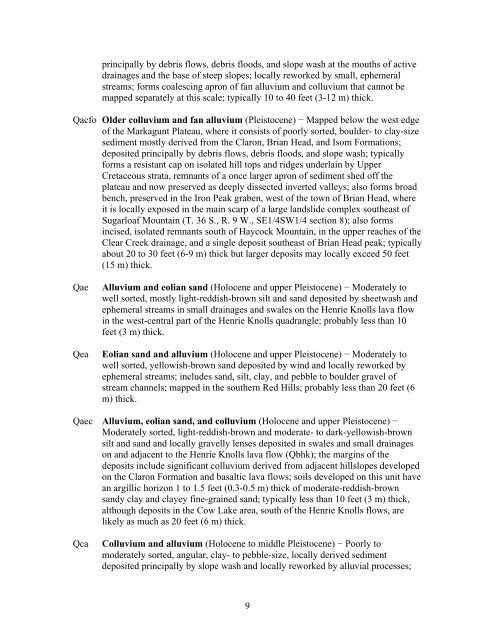Interim Geologic Map of the West Part of - Utah Geological Survey
Interim Geologic Map of the West Part of - Utah Geological Survey
Interim Geologic Map of the West Part of - Utah Geological Survey
You also want an ePaper? Increase the reach of your titles
YUMPU automatically turns print PDFs into web optimized ePapers that Google loves.
principally by debris flows, debris floods, and slope wash at <strong>the</strong> mouths <strong>of</strong> activedrainages and <strong>the</strong> base <strong>of</strong> steep slopes; locally reworked by small, ephemeralstreams; forms coalescing apron <strong>of</strong> fan alluvium and colluvium that cannot bemapped separately at this scale; typically 10 to 40 feet (3-12 m) thick.Qacfo Older colluvium and fan alluvium (Pleistocene) − <strong>Map</strong>ped below <strong>the</strong> west edge<strong>of</strong> <strong>the</strong> Markagunt Plateau, where it consists <strong>of</strong> poorly sorted, boulder- to clay-sizesediment mostly derived from <strong>the</strong> Claron, Brian Head, and Isom Formations;deposited principally by debris flows, debris floods, and slope wash; typicallyforms a resistant cap on isolated hill tops and ridges underlain by UpperCretaceous strata, remnants <strong>of</strong> a once larger apron <strong>of</strong> sediment shed <strong>of</strong>f <strong>the</strong>plateau and now preserved as deeply dissected inverted valleys; also forms broadbench, preserved in <strong>the</strong> Iron Peak graben, west <strong>of</strong> <strong>the</strong> town <strong>of</strong> Brian Head, whereit is locally exposed in <strong>the</strong> main scarp <strong>of</strong> a large landslide complex sou<strong>the</strong>ast <strong>of</strong>Sugarloaf Mountain (T. 36 S., R. 9 W., SE1/4SW1/4 section 8); also formsincised, isolated remnants south <strong>of</strong> Haycock Mountain, in <strong>the</strong> upper reaches <strong>of</strong> <strong>the</strong>Clear Creek drainage, and a single deposit sou<strong>the</strong>ast <strong>of</strong> Brian Head peak; typicallyabout 20 to 30 feet (6-9 m) thick but larger deposits may locally exceed 50 feet(15 m) thick.QaeQeaAlluvium and eolian sand (Holocene and upper Pleistocene) − Moderately towell sorted, mostly light-reddish-brown silt and sand deposited by sheetwash andephemeral streams in small drainages and swales on <strong>the</strong> Henrie Knolls lava flowin <strong>the</strong> west-central part <strong>of</strong> <strong>the</strong> Henrie Knolls quadrangle; probably less than 10feet (3 m) thick.Eolian sand and alluvium (Holocene and upper Pleistocene) − Moderately towell sorted, yellowish-brown sand deposited by wind and locally reworked byephemeral streams; includes sand, silt, clay, and pebble to boulder gravel <strong>of</strong>stream channels; mapped in <strong>the</strong> sou<strong>the</strong>rn Red Hills; probably less than 20 feet (6m) thick.Qaec Alluvium, eolian sand, and colluvium (Holocene and upper Pleistocene) −Moderately sorted, light-reddish-brown and moderate- to dark-yellowish-brownsilt and sand and locally gravelly lenses deposited in swales and small drainageson and adjacent to <strong>the</strong> Henrie Knolls lava flow (Qbhk); <strong>the</strong> margins <strong>of</strong> <strong>the</strong>deposits include significant colluvium derived from adjacent hillslopes developedon <strong>the</strong> Claron Formation and basaltic lava flows; soils developed on this unit havean argillic horizon 1 to 1.5 feet (0.3-0.5 m) thick <strong>of</strong> moderate-reddish-brownsandy clay and clayey fine-grained sand; typically less than 10 feet (3 m) thick,although deposits in <strong>the</strong> Cow Lake area, south <strong>of</strong> <strong>the</strong> Henrie Knolls flows, arelikely as much as 20 feet (6 m) thick.QcaColluvium and alluvium (Holocene to middle Pleistocene) − Poorly tomoderately sorted, angular, clay- to pebble-size, locally derived sedimentdeposited principally by slope wash and locally reworked by alluvial processes;9
















